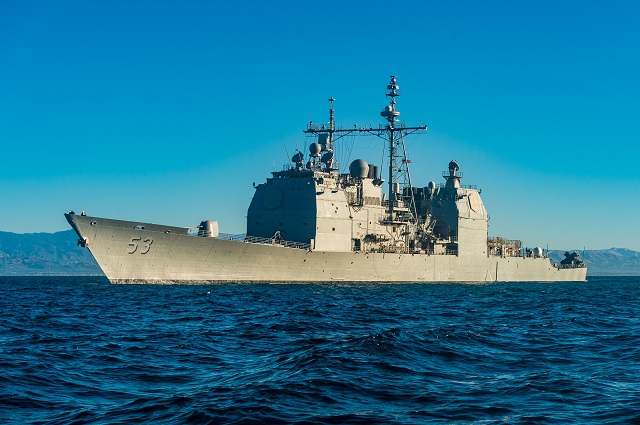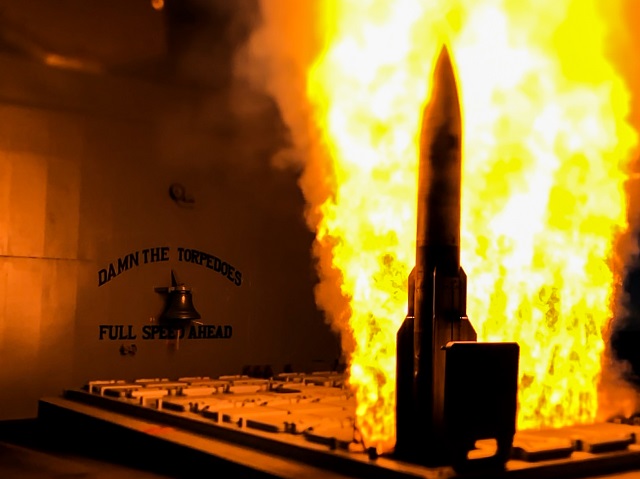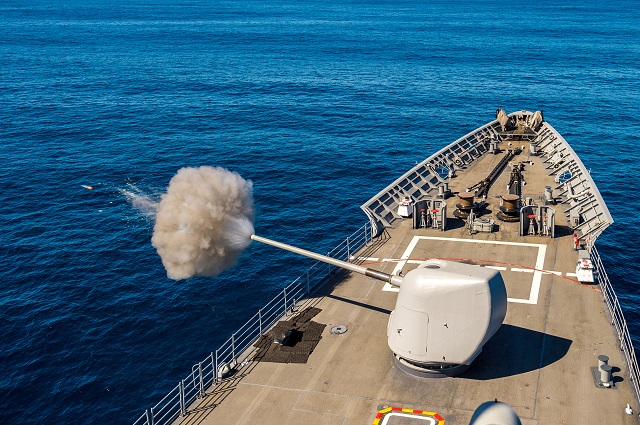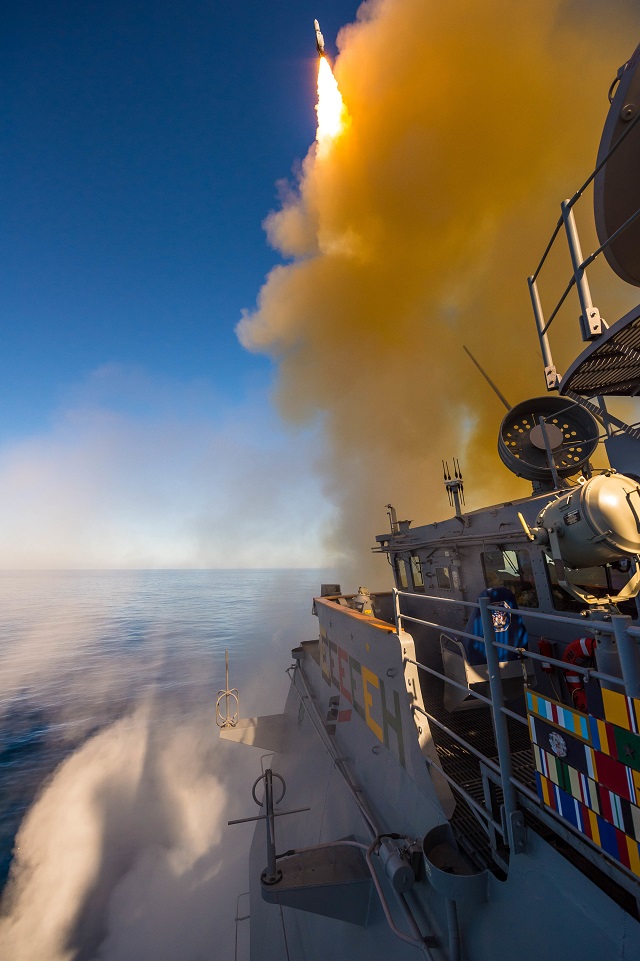|
|
|||
| a | |||
|
Focus - Naval Technology
|
|||
|
|
|||
|
Guided-Missile Cruiser USS Mobile Bay Testing updated AEGIS Baseline 9 Weapons System
|
|||
|
By Mass Communication Specialist 2nd Class Lenny LaCrosse
During a recent underway to test weapons capabilities, guided-missile cruiser USS Mobile Bay (CG 53) conducted a live-fire missile exercise using the updated AEGIS Baseline 9 weapons system. There are currently 84 U.S. Navy ships in service with variations of the AEGIS Weapons System installed: 22 cruisers and 62 destroyers, with Mobile Bay being the first cruiser to upgrade to Baseline 9 software and capabilities, with minor changes in equipment on top of the Baseline 8 system. |
|||
|
|
|||
 PACIFIC OCEAN (Oct. 22, 2017) The guided-missile cruiser USS Mobile Bay (CG 53) transits past Port Hueneme, Calif. Mobile Bay is underway testing the updated AEGIS Baseline 9 weapons system in preparation for its upcoming deployment. (U.S Navy photo by Mass Communication Specialist 1st Class Chad M. Butler/Released) PACIFIC OCEAN (Oct. 22, 2017) The guided-missile cruiser USS Mobile Bay (CG 53) transits past Port Hueneme, Calif. Mobile Bay is underway testing the updated AEGIS Baseline 9 weapons system in preparation for its upcoming deployment. (U.S Navy photo by Mass Communication Specialist 1st Class Chad M. Butler/Released) |
|||
|
|
|||
|
The Navy’s AEGIS program took to sea in 1983 with USS Ticonderoga (CG 47). It was conceived to counter the Soviet variable-geometry wing Tupolev Tu-22M Backfire bombers, which can travel at speeds around Mach 2. The Navy had to develop a ship-based radar and missile system able to detect and intercept an object flying at almost twice the speed of sound.
The need for a total weapon system with the ability to detect, track, engage and destroy gave birth to the AEGIS Weapon System. Operating in concert with the AN/SPY-1 high-powered, multi-function phased-array radar, AEGIS can perform search, track, and missile guidance functions simultaneously, with the ability to track more than 100 targets. |
|
|
|||
 PACIFIC OCEAN (Oct. 24, 2017) An SM-2 missile launches and destroys an airborne training target during a successful first test of the updated AEGIS Baseline 9 weapons system aboard the guided-missile cruiser USS Mobile Bay (CG 53). Mobile Bay, the first guided-missile cruiser in the fleet to upgrade from AEGIS Baseline 8 to the updated Baseline 9, is underway testing new weapons capabilities in preparation for its upcoming deployment. (U.S Navy Photo by Mass Communication Specialist 1st Class Chad M. Butler/Released) PACIFIC OCEAN (Oct. 24, 2017) An SM-2 missile launches and destroys an airborne training target during a successful first test of the updated AEGIS Baseline 9 weapons system aboard the guided-missile cruiser USS Mobile Bay (CG 53). Mobile Bay, the first guided-missile cruiser in the fleet to upgrade from AEGIS Baseline 8 to the updated Baseline 9, is underway testing new weapons capabilities in preparation for its upcoming deployment. (U.S Navy Photo by Mass Communication Specialist 1st Class Chad M. Butler/Released) |
|||
|
|
|||
|
The Navy began building AEGIS cruisers using the hull and machinery designs of Spruance-class destroyers. Beginning with the commissioning of USS Bunker Hill (CG 52), the first AEGIS ship outfitted with the vertical launching system (VLS), and followed by improved AN/SPY-1B radar on USS Princeton (CG 59) and the AN/UYK-43 computers on USS Chosin (CG 65), AEGIS systems took cruisers to the next level in firepower and survivability.
Today, 35 years after Ticonderoga, the basic components of the AEGIS system on cruisers and destroyers (the SPY-1 radar and VLS) have remained pretty much the same, but the threats have gotten faster and deadlier. The Navy has kept ahead of the game, upgrading the AEGIS system to seek and hit ballistic missile targets traveling at speeds up to ten times faster than Backfires and at altitudes in the furthest reaches of the Earth’s atmosphere. |
|||
|
|
|||
 PACIFIC OCEAN (Oct. 24, 2017) The guided-missile cruiser USS Mobile Bay (CG 53) fires its 5-inch gun during a live-fire exercise. Mobile Bay is underway testing the updated AEGIS Baseline 9 weapons system in preparation for its upcoming deployment. (U.S Navy photo by Mass Communication Specialist 1st Class Chad M. Butler/Released) PACIFIC OCEAN (Oct. 24, 2017) The guided-missile cruiser USS Mobile Bay (CG 53) fires its 5-inch gun during a live-fire exercise. Mobile Bay is underway testing the updated AEGIS Baseline 9 weapons system in preparation for its upcoming deployment. (U.S Navy photo by Mass Communication Specialist 1st Class Chad M. Butler/Released) |
|||
|
|
|||
|
For the Mobile Bay, upgrading from AEGIS Baseline 8 to Baseline 9 began in Oct. 2016, as a joint effort between the crew of Mobile Bay, Department of the Navy civilians, and defense contractors.
Mobile Bay is the first guided-missile cruiser to upgrade from Baseline 8 to the Baseline 9 system without having to completely install all new equipment; increasing accuracy, range and weapons capabilities aboard the ship. This upgrade demonstrated that ships don’t need excessive yard periods and complete system overhauls to expand their capabilities thanks to open architecture environments and commercial off-the-shelf designs. One major update that Baseline 9 provides over Baseline 8 is the integration of the Navy Integrated Fire Control- Counter Air (NIFCA-CA). NIFC-CA connects assets within a battlespace through cooperative engagement capability, allowing a Baseline 9 cruiser to receive the targeting solution needed to fire their weapon without having organically sensed the target. Being able to fire on a target well before a ship’s own sensor sees them, allows for increased standoff distances to begin an engagement and enables the entire fleet to manage intercepts of high-speed threats by the best suited defensive asset. |
|||
|
|
|||
 PACIFIC OCEAN (Oct. 24, 2017) An SM-2 missile launches and destroys an airborne training target during a successful first test of the updated AEGIS Baseline 9 weapons system aboard the guided-missile cruiser USS Mobile Bay (CG 53). Mobile Bay is underway testing the updated AEGIS Baseline 9 weapons system in preparation for its upcoming deployment. (U.S Navy photo by Mass Communication Specialist 1st Class Chad M. Butler/Released) PACIFIC OCEAN (Oct. 24, 2017) An SM-2 missile launches and destroys an airborne training target during a successful first test of the updated AEGIS Baseline 9 weapons system aboard the guided-missile cruiser USS Mobile Bay (CG 53). Mobile Bay is underway testing the updated AEGIS Baseline 9 weapons system in preparation for its upcoming deployment. (U.S Navy photo by Mass Communication Specialist 1st Class Chad M. Butler/Released) |
|||
|
|
|||
|
During a recent live fire missile exercise, Mobile Bay fired two Standard Missile 2 (SM-2) missiles and one Enhanced Sea Sparrow Missile (ESSM) from the forward launcher on the forecastle.
For the first time in Navy history, Mobile Bay demonstrated the enhanced capabilities the updated AEGIS system brings to the fleet by engaging an SM-2 missile using only the SPQ-9 radar system. The ship’s missiles successfully tracked, engaged and destroyed three unmanned aerial vehicles used to simulate airborne threats during the exercise. With the ability to provide multi-mission offensive and defensive capabilities, AEGIS cruisers can operate independently, as part of an aircraft carrier strike group or within surface action group in support of global operations. The Navy is currently modernizing the fleet’s 11 newest cruisers, updating the ships’ combat systems and hull, mechanical, and electrical systems. This modernization plan will extend the service life of these ships from 35 to 40 years, ensuring relevant and capable purpose-built air defense commander platforms into the mid-2030s. |
|||










